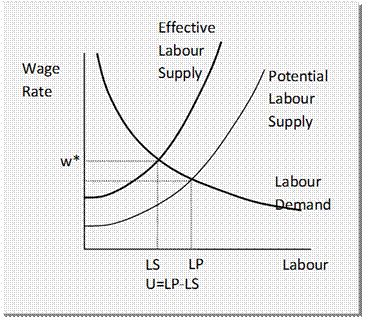Capital and labour markets - GEM-E3
| Corresponding documentation | |
|---|---|
| Previous versions | |
| Model information | |
| Model link | |
| Institution | Institute of Communication And Computer Systems (ICCS), Greece, https://www.iccs.gr/en/. |
| Solution concept | General equilibrium (closed economy) |
| Solution method | Optimization |
| Anticipation | |
Labour Market
The GEM-E3 model adopts the EUROSTAT definition of the labour force and thus it is computed by multiplying the participation rate to total active population. The databases mainly used to extract these data are the EUROSTAT, ILO and World Bank. The GEM-E3 model has detailed representation of skilled and unskilled labour force by sector of activity, including detailed representation of labour force in the power generation sectors.
The formulation of the labour market adopted in the GEM-E3 assumes the presence of imperfections and rigidities which shift the exogenous labour supply (in the alternative version the utility-derived labour supply), to the left and upwards. Wages drive the balancing of the shifted labour supply with labour demand. Thus involuntary unemployment arises as a result of the distorted labour market equilibrium. The model distinguishes labour between skilled and unskilled labour. Capital and skilled labour substitute each other (except for power generation technologies, where capital and skilled labour complement each other), at the 4th level of production, while capital and skilled labour bundle are substitutes with unskilled labour at the 3rd level of the production. Equilibrium unemployment is modeled for both skilled and unskilled labour.
It is assumed that, due to labour market imperfections and frictions, the employees enjoy a wage premium (a wage rent) on top of the wage rate that would correspond to equilibrium between potential labour supply and labour demand. The wage rate premium leads to a displacement to the left of the potential labour supply curve. The displaced supply curve corresponds to effective labour supply.
In the standard version of the GEM-E3 model labour market is perfect in the sense that wages adjust until there is no excess labour supply and hence unemployment. The model considers the notion of voluntary unemployment through the choice of household for leisure (when the alternative version of labour market is used). In the standard version the representation of involuntary unemployment is based on the efficiency wages approach by Shapiro and Stiglitz (1984).
The wage rate premium is endogenous to the model and is assumed to be the consequence of the existence of Principal-Agent relations: the firms are obliged to pay a wage premium to induce employees not to shirk; as a result effective labour supply is determined through efficiency wages.
The balancing of labour demand with effective, rather than potential, labour supply implies that equilibrium unemployment is determined as the difference between potential and effective labour. This is illustrated in the Figure below which shows unemployment U as difference between potential equilibrium labour LP and effective labour equilibrium LS, corresponding to wage rate w* which includes the wage rent reflecting market imperfections.
Figure 2.1: Illustration of equilibrium unemployment
An approach for simulating involuntary unemployment relates to the assumption that there is a negative correlation between wages and unemployment. This approach is consistent with the efficiency wages theory of Shapiro & Stiglitz (1984) which states that productivity/quality of labour has a positive correlation with wages. In periods with high unemployment firms are not motivated to offer high wages to attract higher quality labour or to increase productivity of existing workers. On the other hand, at low unemployment rates it is efficient for firms to offer wages above their equilibrium level, because they seek for increases in labour productivity and for reducing the probability of someone quitting the job and hence reducing costs from the recruitment of new personnel. In the GEM-E3 model the efficiency wage approach was finally selected to be the default option for representing involuntary (equilibrium) unemployment. This modelling approach was preferred because of its empirical validation, by using for example Blanchflower and Oswald (1994), its simplicity, and the fact that it is parsimonious in parameters.The specification of efficiency wages in GEM-E3 is based on Shapiro & Stiglitz and Annabi (2003) approaches. The procedure is identical both for skilled and unskilled labour. Efficiency wage is an increasing function of quit rate, the probability of finding a job, the interest rate and the unemployment benefit. In equilibrium the number of workers that are unemployed should equal the number of workers that fill a vacancy.
The implementation of involuntary unemployment in the GEM-E3 model requires additional data (i.e. unemployment levels, minimum wages etc.) that are extracted mainly from the CESifoDICE and EUROSTAT databases.
Capital Market
In the GEM-E3 model firms are modelled to maximize their profits, constrained by the physical capital stock (fixed within the current period) and the available technology. Producers can change their physical capital stock over time through investment. Capital stock data by sector of production are not available either from GTAP or from EUROSTAT databases (it is computed in the calibration phase of the model). Capital markets clear through interest rates which influence investment.
In the GEM-E3 model, investments are computed:
i. by applying the uniform investment coefficients based on gross fixed capital formation found in the IO tables and by adding additional data for specific branches (where available)
ii. by applying a RAS method in order to ensure that the investment shares are in line with the consumption of the fixed capital.
Three alternative choices for the capital mobility are assumed in the model:
i) Capital is immobile between sectors and between regions.
ii) Mobility across sectors but not across regions.
iii) Full mobility across sectors and regions.
